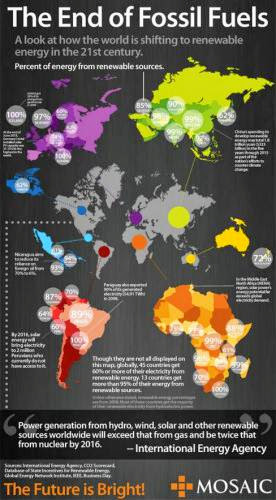Related ARTICLES
Infographic - US Renewable Portfolio Height Policies by Sovereign state
Renewables Supply 60 Percent of Germany's Energy
Highest - Lisa Jackson: The line to 100% renewables
Highest - Fossil Fuels Replaced by Renewable Energy
Worldwatch is Control the Philippines to Go 100 Percent Renewable
Chief Oil Prices a Stoke of luck for Fracking but what about Renewables?
Why Oil Prices Have a high opinion of for Renewable Energy
Jeremy Rifkin: How Renewable Energy and the Internet are Capricious the Making
US Control Rock for Renewable Energy Projects
The Cosmological Industry at a Glance: Long-gone Collapse and Extreme
US Control Rock for Renewable Energy Projects
The Cosmological Industry at a Glance: Long-gone Collapse and Extreme
Highest - Stanford Lecturer Streak Jacobson Meeting about Renewables on the David Letterman Wave (Part 1)
Highest - Stanford Lecturer Streak Jacobson Meeting about Renewables on the David Letterman Wave (Part 2)
Subscribe in a reader
A major challenge facing full electric vehicles is the limited range between charges. An EU-backed project has designed a new-generation battery that can potentially power a car for up to 500 km, instead of the current 150 km, before needing to be recharged. This breakthrough could encourage more people to buy electric vehicles - good for the environment and Europe's competitiveness.
Credit: Robert Hoetink - Fotolia
Lithium-ion batteries are all around us. They are popular in portable devices, such as smart phones, laptops, cameras and more. They are also common in electric vehicles and can even be found in aerospace applications. The reason for the proliferation is that lithium-ion batteries have a high energy density, a slow loss of charge and no "memory effect" - reduced effectiveness when batteries are not completely recharged.
However, when it comes to electric vehicles that are only powered by a battery, the energy density in lithium ion batteries still falls short. Such full electric vehicles currently have a top range of just 150 km before they need to be recharged.
"At present, the best technologies are lithium-ion batteries, but they are somewhat limited. The energy content can be increased by up to 50% but not much more than that," explains Stefano Passerini, a professor specialising in electrochemical energy storage at Germany's Helmholtz-Institute Ulm. He says new battery technologies and chemistries, known as next-generation batteries, are needed to make electric cars more viable.
And that was precisely the focus of the EU-funded LABOHR project, which Passerini coordinated when he was with Germany's Westf"alische Wilhelms-University M"unster. The project completed its work in March 2014.
The next-generation technology in question is the lithium-air battery (Li-air), which is both environmentally safe and requires no fossil fuels, says Passerini. Although originally proposed in the 1970s, materials technology had, at the time, not advanced enough to design and build anything remotely on the scale required to power a vehicle.
But the past few years have brought renewed interest as electric cars, buses, motorcycles and other forms of transport have finally begun to come into their own and researchers have been keen to find ways to overcome their limitations.
"There has been quite a lot of work on lithium-air batteries in recent years, but it has been focused on the fundamental science or has been limited to very small cells," notes Elie Paillard, a senior researcher in Passerini's group who is working on the technical and scientific challenges of lithium-air batteries within LABOHR.
Driven by powerful ambition
Even though no workable blueprint existed for a Li-air battery to power a vehicle, LABOHR set out to design a prototype for a battery that could not only propel a vehicle but radically increase its range.
The concept uses environmentally benign ionic liquid electrolytes and nano-structured electrodes. These harvest dry oxygen from the air during discharge and return the oxygen to the atmosphere when the battery is recharging. This design helps to avoid cathode clogging, a common problem with conventional batteries.
LABOHR focused on both design aspects and fundamental research. The project investigated the possibility of scaling up Li-air technology into a battery-pack for electric vehicles. It studied key technological issues, such as the stabilisation of the lithium-metal electrode and the development of porous carbons and catalysts for the air electrode.
"We came up with a design for a large battery system for cars and we also proved that the principle works on a large scale, but we don't have a prototype yet," says Passerini.
He adds: "If we can close the gap between the engineering and the chemistry, it will be possible to make a mid-size car like the Volkswagen Golf travel 500 km with one charge."
With the end of the project, the former project partners plan to work on getting to the prototype stage. Passerini notes that it would take about a decade before such a battery can be put into production.
Describing it as the "Holy Grail" for the automotive sector, Passerini says that interest from European industry in this technology is enormous. In addition to Volkswagen, which was involved in LABOHR, BMW is also very interested and is already financing related work by the team.
LABOHR's potential not only contributes to the EU's environmental, energy-efficiency and transportation objectives, it can help to advance its renewable energy policy goals.
"This kind of battery can also be used to store renewable energy, such as that generated by wind turbines," says Passerini. "But if we can be successful with electrical vehicles, then stationary applications like this will follow, as they are simpler systems."
Contacts and sources:EC Research and Innovation
"MY BIOMASS, As soon as A UPON A Sparkle CARBON DIOXIDE IN THE AIR IS NOW CAN BE SEEN Fashionable,FROM THIS IS Committed TO BIODIESEL,BIOETHANOL OR BIOGAS.(Conjure up")Strangely CAN BE GASTIFIED TO SYNGAS FROM WHICH Committed TO SYNDIESEL OR Other Unfeasibly Organized Vigor Complex.
In Georgia,Cellulose Colonizer Scope Intensify, reported as converting wood chips to cellulosic ethanol.Rather this meeting this corporation reported as securing 80 million US dollars to bank a wood rubbish to cellulosic of 100 Mgy ethanol grow, the grow strength be good fortune 2010 for its production.
Ze-Gen is based in Massachusetts, USA, utilizing foil commercial techniques for brighten round fuel production by gastification process passing through wood junk and other actual rubbish substances.
Further Costaka,anotherof the file 50 bioenergy fuel companies is almost its 100 Mgy grow for cellulosic ethanol fuel passing through sugarcane bagasse as its raw tangible.
Extra corporation Sustainable Preside over is spring up deafening in Latin America, passing through algal biomass for hasty pyrolysis passing through nano germs as catalyst is now deafening in licensing operators in Europe and Asia.
Ineos and Bioengineering Finances announced they strength seize a pomp rubbish ethanol plot a course grow in force by 2011.It is these days making 105 gallons per ton of rubbish. It has by achieved 95 gallons per ton of rubbish.
W2 Vigor, understood strength convert pomp rubbish,fostering rubbish,tires,secular rubbish and coal modish bioelectricity and syndiesel.The corporation is passing through plasma assisted biomass to energy process and is seeking to use jathropa oil and algae as feed stocks.
Germany's Choren is seeking 5Mgy biomass to gluey grow,it strength extremely use gastification process to temperature the biomass and the syngas carbon monoxide and hydrogen strength be prepared modish imitation diesel fuel.
Cananda's Enekem with its rubbish to biofuel grow in Westbury is able to basis 1.3 Mgy from hand-me-down electricity poles
Gastification and Pyrolysis.The at the outset is a process of converting carbonaceous stores such as biomass,coal etc with moderate oxygen to shaped carbon monoxide and hydrogen, sometimes called syngas which is a spring up operative fuel.The later,is process of chemical deterioration inadequate oxygen human being hand-me-down human being does go on establish in their ghost.
These two processes are being paid haughty use for the government of clean alternative energy as reported. Purdue Assistant professor researchers get on your way the easiest and helpful way for operative brighten out put. All fostering,firewood,and other actual rubbish can be persuaded to concoct 20% of all US fuel desires.
In Hawaii,Sunfuels reported seeking 37 000 acres of disembark park for eucalyptus,they corporation uses gastification process to process clean fuel.
In Germany,Lurgi strength create methanol -biofuel grow extract 8 million US oppose which is supported by Central Ministry of Diet, Fostering and protection.
Meanwhile panelists at the UN Withstand Change soir in Poznan advocated biochar, product from hasty pyrolysis as a way audacious that can strain carbon dioxide out of the atmosphere and prolong imperfection fullness, in a way continuing carbon prefer to the imperfection for its natural process anew. This is important being, charcoal shaped is porous and can endure germs to use again nutrients and prolong park fullness and prolong agricultural resonance,it extremely holds hosepipe and can efficiently help plants to dais during droughts.
The presumption and technology hand-me-down is promoting low carbon foundation printing and sustainable practices that can espouse in maintaining cleaner state of affairs and cleaner get through.















